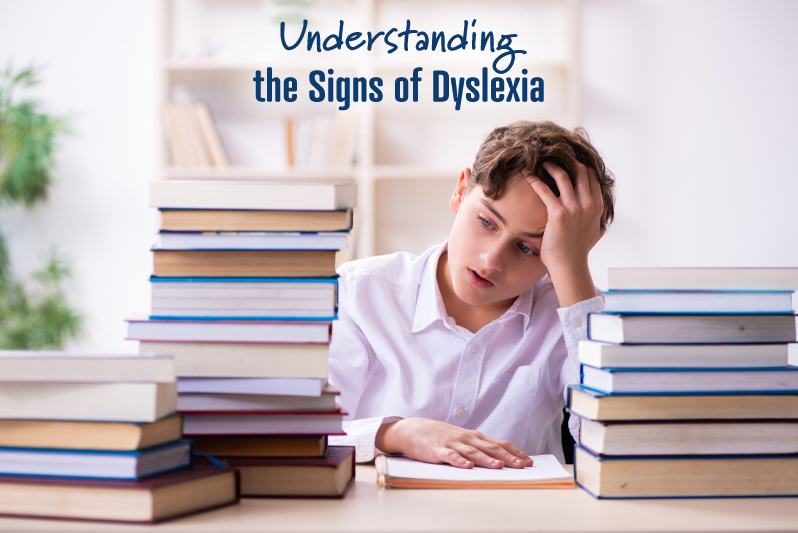
Dyslexia is a learning difficulty that primarily affects reading and spelling. While children develop at their own pace, parents may notice when their child struggles with reading, especially compared to siblings or peers. Early identification and intervention are key to overcoming these challenges. By recognizing the signs of dyslexia early, parents can seek timely support that significantly boosts a child’s reading skills and confidence.
At Lindamood-Bell, we believe all individuals, including those diagnosed with dyslexia, can be taught to read and comprehend to their full potential. Our evidence-based, individualized instruction strengthens the sensory-cognitive processes essential for reading and comprehension success.
Our process begins with a comprehensive Learning Ability Evaluation to identify underlying learning challenges and gain a clear understanding of your child’s unique needs. Based on this evaluation, we create a personalized instruction plan designed to address the root causes of your child’s learning difficulties. Take the first step toward transforming your child’s future—schedule a Learning Ability Evaluation today.
Roan’s Story: A Journey to Reading Success for a Student with Dyslexia
Roan’s mother, Ruth, noticed early on that Roan struggled with reading. He would come home from school feeling frustrated and upset, often in tears. Shortly after, Roan was diagnosed with dyslexia and could not read even a single word.
Ruth turned to Lindamood-Bell for support, and after participating in our intensive online instruction, Roan was reading at grade level. His remarkable transformation highlights the impact of our approach.
Watch Roan’s story:
Signs of Dyslexia
While reading avoidance and frustration are common signs of dyslexia, there are specific behaviors to look out for:
1. Sounding Out Words
Students with dyslexia often struggle to decode words. They might skip or substitute sounds, leading to inaccurate reading. For example, a child may read “steam” instead of “stream.”
2. Sight Words
Children with dyslexia may have difficulty remembering sight words such as “eye” and “thought.”
3. Reading Fluency
Even when they can decode words, students with dyslexia may not read fluently. Their reading may sound choppy or disjointed, which can interfere with understanding the meaning of the text.
4. Spelling
Spelling challenges often accompany dyslexia. Even if a student can spell phonetically, they may not remember the visual patterns of words (orthography).
One possible cause of these difficulties with reading and spelling is weak symbol imagery—the ability to visualize letters and words. A significant number of students—even those who have well-developed phonemic awareness—have difficulty rapidly perceiving sounds in words and are slow to self-correct their reading errors. Individuals of all ages can experience the symptoms of weak symbol imagery.
This causes weakness in:
- Memorizing sight words
- Sounding out words
- Orthographic awareness
- Phonemic awareness
- Contextual reading fluency
- Orthographic spelling
Our instruction features the Seeing Stars program, which develops symbol imagery for reading and spelling. Long overlooked in reading research, symbol imagery is an important function that can now be assessed and developed.
How Reading Intervention Changes the Brains of Children with Dyslexia
Recent research titled “Rapid and widespread white matter plasticity during an intensive reading intervention” was published in the journal Nature. The study, from the Institute for Learning and Brain Sciences, University of Washington (UW), examined growth in reading skills and white matter in school-aged, struggling readers. Diffusion MRI data collected during eight weeks of Lindamood-Bell intensive instruction indicates that there were large-scale changes in white matter along with growth in reading skills. In addition, the study identifies white matter tracts that may predict the ease with which a child learns how to read.

Dr. Jason Yeatman, one of the study’s researchers, says that although dyslexia is often thought of as permanent, the findings indicate that the targeted, intensive instruction leads to “substantial” improvements in reading skills and changes in the “underlying wiring of the brain’s reading circuitry.” Read more and access the full article here.
Find more independent research studies and references here.
Symbol imagery—the ability to visualize letters and words— can be improved through targeted instruction. Improved symbol imagery changes how students read and spell, regardless of their ages or their struggles with literacy—including students with dyslexia.
Numerous peer-reviewed articles based on studies examining the effectiveness of Lindamood-Bell instruction with dyslexic students have been published in scholarly journals – Summary of Behavioral & Neurological Research—Dyslexia.
Hope for Students with Dyslexia
At Lindamood-Bell, students receive individualized instruction using one or more of our evidence-based programs. The Seeing Stars program develops skills needed for phonological processing and orthographic processing in reading and spelling. Seeing Stars instruction can address the needs of students previously diagnosed with dyslexia. From 2008 to 2023, we worked with over 3,000 students who self-reported a dyslexia diagnosis. These students experienced large (statistically significant) improvements in reading accuracy, fluency, and comprehension after receiving Seeing Stars instruction.
The following shows the reading performance, pre- and post-instruction, of all students who self-reported as having a diagnosis of dyslexia.
Lindamood-Bell® Learning Center Results—Students with Dyslexia

Years: Jan. 2008 – Dec. 2023
Number of Students: 3,034
Average Age: 10.2
Average Hours of Instruction: 123.9
Lindamood-Bell Instruction Implemented: Seeing Stars
On average, students with a prior dyslexia diagnosis who received Seeing Stars instruction achieved significant improvements in reading. They made large (statistically significant) standard score changes on seven of eight measures. Vocabulary was not a targeted measure of instruction. The 20-point percentile increase in Word Recognition put these students well within the normal range (25th–75th percentile). The large average standard score change in Paragraph Reading Accuracy should also be noted.
Find additional Learning Center data, including growth made by students with ADHD, Specific Learning Disabilities, and Autism here.
Help for Dyslexia at Lindamood-Bell

At Lindamood-Bell, we offer individualized, evidence-based instruction to help students with reading difficulties, including those diagnosed with dyslexia. Whether your child is newly diagnosed or has struggled for years, we believe dyslexia doesn’t have to be a lifelong challenge. For over 35 years, our sensory-cognitive approach has provided hope and lasting results, helping students overcome their reading challenges. We can help your child reach their full potential—learn more about our programs today. Call us at 800-233-1819 or request information.






